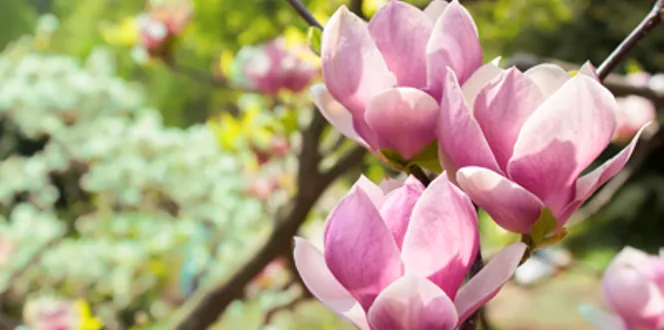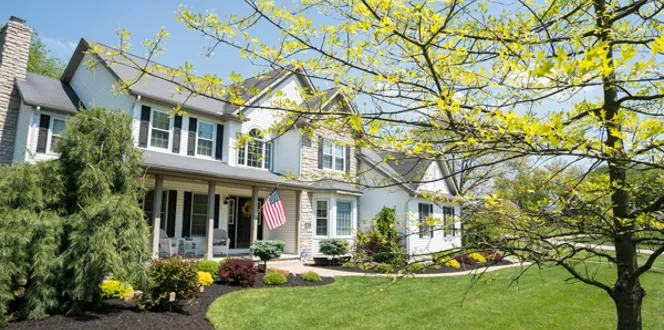Flowering trees add tremendous impact to your home landscape. They bring color, variety, lovely scent, and a welcome change during seasonal shifts.
But since there are so many varieties of flowering trees, you may be wondering which ones might be best for your yard. In fact, the Royal Botanic Gardens says there are more than 369,000 flowering plant species in the world. That’s a lot to choose from.
We’re here to help. The Davey Institute’s technical advisor, Chelsi Abbott, shares some of the best small flowering trees, as well as some recommendations for low-maintenance varieties and trees with particular habits you should avoid.
She also shares some planting tips so your tree gets a great start in its new home.
Her topics include:
- What’s considered a small tree
- Things to consider when choosing the right tree
- Small flowering tree recommendations
- Trees that can cause trouble
- Spring planting care
For even more advice from Abbott, listen to her full podcast on this topic here.
Tree Sizing Guide: What’s Considered a Small Tree
If you have a smaller yard or less space to add a tree, you might be on the lookout for a small flowering tree. But what size is actually considered small?
Some resources say that 15 feet in height or shorter is considered a small tree. But, as Abbott explains, the definition of small is really dependent on each individual person rather than following some general recommendation.
“Some people might think shrubs are small trees or something under 10 feet tall is small,” she explains. “But other people might think anything under 30 feet tall is small.”
Choosing the Right Tree
There are many things to consider when selecting a tree for your yard.
- You want to know the mature height and spread of the tree to know if the species you like will properly fit the space.
- You want to know the sun and water needs, as well as soil preferences, so you know if your space gives your tree what it needs to grow.
- You also want to know your desired tree’s insect and disease susceptibility, especially with flowering trees since they can have more of these issues.

“I typically recommend flowering trees that don’t have a lot of disease or insect problems,” Abbott shares. For instance, “I love a good cherry tree, but they have a really bad disease called black knot that gets on them, so I have to kind of kick them off of my list.”
Flowering Trees Recommendations
Here’s a list of the best small flowering trees that Abbott recommends:
Kousa Dogwood - This tree has a beautiful raspberry-like fruit, so it provides nice late summer/fall interest, as well as signature flowers in spring that are pink or white. The big difference with Kousa dogwood is its resistance to a fungal pathogen that can cause a lot of cankers on the tree.
Catalpa - Catalpa is one of Abbott’s all-time favorites because it looks interesting no matter what time of year you’re in. It has a knobby bark that’s very large and ridged and creates a unique form. It also has giant, heart-shaped leaves, as well as big, beautiful bean pods. In mid-summer, this tree forms beautiful, white, orchid-like flowers. It’s a very dramatic tree.
Japanese Tree Lilac - This tree has leaves that look like hearts, and it blooms a little later than typical ornamental trees, so you can incorporate it in your yard with your other spring-flowering trees to get a staggering of bloom times. The flowers have a sweet smell that is like honey. Since these aren’t often planted, you have a better chance of not having an insect or disease come through and wipe them out.
Partridge Pea - This tree isn’t super common and it’s typically more of a shrub, but they can be grafted into an ornamental flowering tree shape that lifts them off of the ground a bit. It has beautiful yellow flowers and leaves similar to a honey locust or black locust.
Rose of Sharon - This tree can look interesting in the winter because they have a visual uniqueness, which actually remains all year long. It’s also pretty resistant to common insect and disease issues and is quite low maintenance.
Hydrangea - While this is a common perennial shrub, it can be grafted into a tree. The snowball-like flowers in pink, blue, and purple are great for attracting bees.
Fringetree - This one isn’t one you see a lot, but whenever you do you have to stop and look at the flowers. They don’t really have petals; they are more like colorful strings. When it’s in bloom it’s almost like a smoke tree or bush -- very feathery. It is very delicate-looking. The leaves are also interesting, so when the blooms fall you still have some visual interest. This is also a smaller tree, so it fits in places where a crabapple or serviceberry may also fit.
Redbud - The flowers on a redbud are magenta -- so bright. And they bloom at a time of year -- early spring -- when everything else is still kind of dormant, so it’s a great visual.
Trees to Avoid Planting that Can Become Too Much Work
When it comes to flowering trees you want to stay away from, Abbott had some pointers.
Cherries and plums, unfortunately, have a problem with the black knot fungus, so these aren’t the best choices for your yard.
Crabapples, though gorgeous, also get fungal and bacterial diseases, making them require more work to maintain.
All three of these trees are also quite overplanted, and anytime this happens there is a greater risk for an insect or disease to come through and infest a large group of similar trees.

Spring Tree Planting & Tree Care Tips
When planting trees, spring and fall are the best times to do so since you don’t have the weather extremes of summer and winter to content with.
Fall is really the best time because the tree gets a chance to become established over this milder season and through winter before the big spring growing season. But spring also works; you just have to be more cautious about freezes after planting and the upcoming drought potential in summer.
Your main goal when planting a tree is to ensure the tree recovers from the shock of being placed in its new home. Here are a few tips from Abbott to ensure planting success:
- Watering - Water your new tree about 1 inch or so each week. If you don’t know how much water your landscape is getting, place a coffee tin or tuna can out and mark an inch on the side with a Sharpie. Water until that can is full to that mark and that will tell you how long you should water to reach that measurement.
- Know Your Tree’s Drip Line - When you look at the green canopy of your tree, the drip line is essentially when rain comes down it will hit the tree and fall around it underneath the canopy and branches. That is your tree’s drip line -- the area in which you want to conserve moisture.
- Mulching - This is the best thing you can do for your tree. Put down a 2 to 4-inch layer of mulch under the tree’s drip line, keeping it away from the base of the tree, meaning don’t let mulch touch or pile up on the bark. This can create an environment for fungal pathogens, which is why we avoid it.
- Fertilizing - Soil has three components. Your nutritional component is going to be your fertilizer, and you’ll want to at least talk to an arborist about this when you put a new tree in. Then you also have the physical component, such as soil compaction, which is when soil is squished down, limiting water and air to the roots. Mulch helps break this down over time. The third one is the biological component, which is made up of the microbes living in the soil. Fertilizer is a part of your soil program that can help address these issues -- like a tool you can use along with mulching and watering to help enable your tree to receive what it needs to grow.





